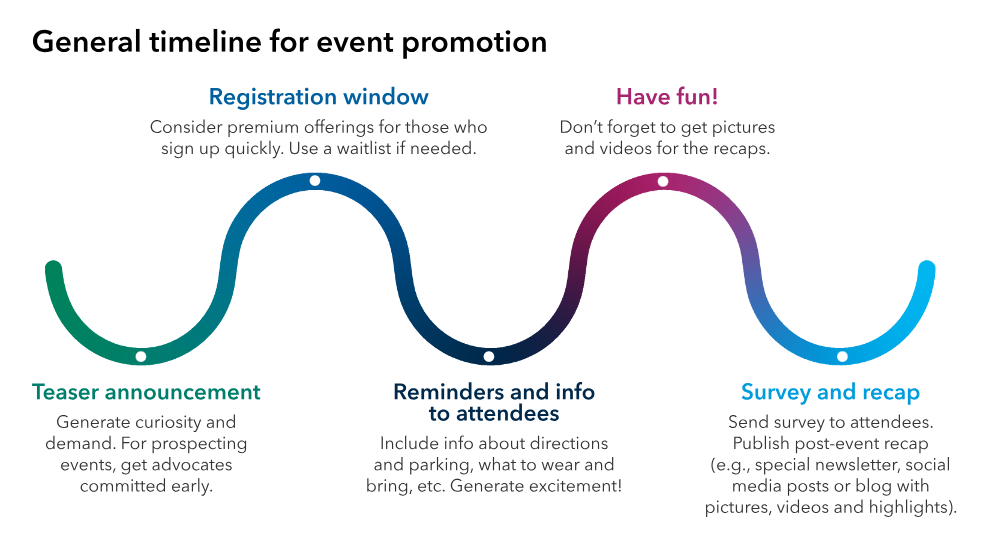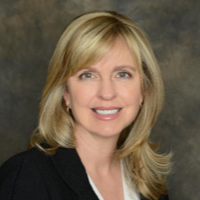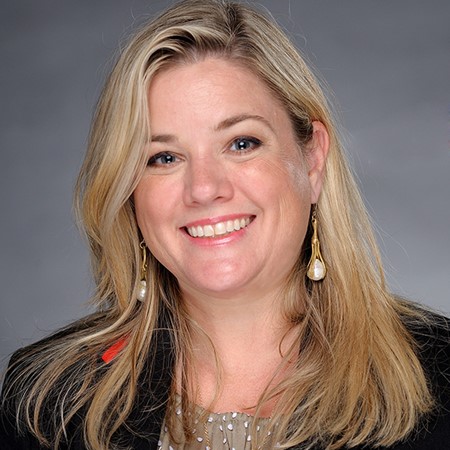Practice Management
Client appreciation and prospecting events consistently generate revenue growth for financial advisors.* But planning a fun, engaging and informative event with good return on investment (ROI) can be difficult. If you're not a full-time professional event planner, how do you come up with a good event idea, and how do you bring that idea to life?
To help you get started, Capital Group published a concise list of event ideas. When it comes to executing on your idea, there are time-tested event planning tools and tactics you can adopt. Every year, Melissa Sloane, Leah Ryan and Matt Robinson of Capital Group help hundreds of advisors plan events, along with all other aspects of practice management. They have identified five best practices for advisors planning events:
- Start with the ideal client and work backward.
- Form partnerships to multiply your impact.
- Build the invite list carefully.
- Promote early, broadly and frequently.
- Find creative and subtle ways to incorporate your brand.
1. Start with the ideal client and work backward
You should have already defined your ideal client persona (ICP). Research has shown that firms with a defined ICP, value proposition and marketing plan attract 42% more new clients and 45% more new client assets.**
Events are no exception. Your ICP should dictate your event’s subject material. Think about your ideal client’s biggest needs and select a topic that addresses one of them.
Your ICP should also dictate your event’s format. Events can offer networking, education or a mix of both. Determine which your ideal client values more and allocate time in your event’s agenda accordingly.
“Think about every last detail from their point of view,” suggests Robinson. Select a day and time that works well for your ideal client. Consider your target audience’s physical condition when deciding how active attendees will be. Decide between virtual and in-person formats and pick a venue based on your target audience’s location and proximity.
2. Form partnerships to multiply your impact
Sloane observes that “events about personal finance led by financial professionals are commoditized.” Her recommendation is to partner with another nonfinancial business that has a marketing budget and whose target audience overlaps with yours. “After all, they want to deepen relationships with clients and prospects, too,” she says.
A partnership multiplies the subject matter expertise and activities you can offer, audience you can reach and likelihood of success. It also allows you to divide the work with someone else, lightening your load.
There are two different approaches to identifying partnerships. Should you pick a good event idea first, then find a partner that fits it? Or think about potential partners in your network, then come up with an event based on what they do? “Generally, we recommend picking the idea first, because you can cater it to your ideal client instead of shoehorning it in,” Sloane advises, “unless, of course, you happen to have a friend who’s a famous Grammy-winning musician and want to put on a songwriting workshop!”
3. Build the invite list carefully
There are three ratios to keep in mind when it comes to how many people to invite:
Attendees and advisors from your firm. “Unless you’re doing a webinar where you don’t need to limit the number of attendees, I’d recommend sticking to 20 attendees per advisor,” says Ryan. “We’ve found that’s the optimal ratio to facilitate meaningful interactions.”
Invitees and attendees. Once you’ve determined the number of attendees you’d like to have, determine how many people to invite to reach that number. This ratio varies widely by type of event. As a rule of thumb, invite 10 people for every one attendee you’d like to have, but err on the side of inviting more and use a waitlist to generate demand. Avoid scrambling to fill seats or ending up with attendees who don’t fit your ICP. Track what percentage of invitees become attendees. That will inform how many you invite the next time.
Clients and prospects. At prospecting events, bring clients who can be influential advocates for you. Spread them out among prospects. For instance, if there are 35 attendees at five tables, Ryan suggests having one advocate and six prospects at each one.
Regarding the third ratio, Robinson notes, “Invitations are previews of referrals.” Rely on your partners and clients to bring people to prospecting events. The key is to equip them to bring the right type. Robinson suggests using language like, “Know anyone who…?” and “This event is perfect for…” with a description of your ICP. Reiterate your value proposition with language like, “We’re putting on this event because we care about …” and “This is what we do best …”.

Sloane has two other recommendations about whom to invite. “Unless there’s a couples-specific angle, invite individuals without their partners,” advises Sloane. “Inviting couples halves the number of households in the room, and couples are more likely to stick to themselves.” She also finds that women are generally more natural connectors and conversationalists than their male counterparts.
4. Promote early, broadly and frequently
“Leverage all your platforms,” recommends Ryan. “Add the event to your website and social media. Amplify via email and direct mail. Put up a flyer in your office. You might even consider buying ads that reach your target audience.” Marketing your events should flow naturally from your broader digital marketing strategy.
Follow this general timeline:

Your customer relationship management (CRM) software can help you manage touchpoints with invitees. Populate it with data about your invitees, like contact info, location, occupation and financial planning needs, that you can begin collecting even before the event with an application or registration form. Having good data allows you to create touchpoints with both clients and prospects and to measure the ROI on your event.
5. Find creative and subtle ways to incorporate your brand
“We’ve all attended events where they just slap logos everywhere,” says Sloane. She encourages advisors to instead create a “multichannel experience.” Create QR codes (for free) that link to your website. Have printed copies of firm collateral.
“For bonus points, make everyone interact with your brand across the different channels while they’re at the event,” Sloane suggests. Have attendees download something they need for the event by scanning a QR code printed on an insert inside the firm brochure. Enter people into a raffle when they follow your firm’s LinkedIn page or subscribe to your newsletter.
When it comes to giving people things to take home, “people don’t need more mugs or pens,” Ryan points out. Attendees are more likely to keep things they make themselves, like a flower bouquet they arranged or brand kit for their business. Think about things people can use in their daily lives, like a personal meal plan or exercise schedule. “The goal,” says Ryan, “is to keep your brand out of the trash and in front of these people.”
A successful event can also leave people wanting more. Ideally, your events should be recurring, not one-off occurrences. As Robinson notes, “The first one’s usually the hardest one. You can make the next one even better. And over time, hopefully, you’ll have a bigger share of people’s calendars … and assets.”
RELATED INSIGHTS
-
-
-
Private Markets
* Nerd’s Eye View, “Measuring The ‘Best’ Marketing Strategies And The Second Kitces Research Study On Advisor Marketing,” April 2022.
** Financial Advisor Magazine, “Schwab Says Advisors Who Define 'Ideal Client' Attract 45% More Assets,” July 2023.
 Leah Ryan
Leah Ryan
 Matt Robinson
Matt Robinson
 Melissa Sloane
Melissa Sloane